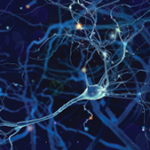“Our modern view of inflammatory pain and inflammation is that when there is tissue damage caused by the cells of the immune system, these act on the nervous system, which in turn can then activate and recruit immune cells, the interaction of the two begin to manifest in pain hypersensitivity,” Dr. Woolf noted.
Central Sensitization
Central sensitization involves an increase in the excitability of neurons in the central nervous system, and patients may have a dramatic response to seemingly innocuous stimuli. Inflammation or tissue damage is not involved. Conditions marked by central sensitization may include fibromyalgia, irritable bowel syndrome, and temporomandibular joint disorder. In the past 10 to 15 years, scientists have learned that, in central sensitization, there is a change in the synaptic connections between nociceptors and neurons. The synaptic connection is not fixed but plastic and flexible, he noted. A change in synaptic efficacy increases the excitability of the neurons in the central nervous system.
In central sensitization, proteins may be altered due to a process called phosphorylation, Dr. Woolf said. This process, in which a phosphate is added to the protein molecule, can dramatically alter the protein’s properties that result in lowered pain threshold or heat sensitivity levels. Phosphorylation may also extend the duration of sensitivity for hours, but typically recovers. However, transcriptional changes in the central nervous system also can occur in some situations, and they and the pain hypersensitivity they produce may be long lasting or even permanent, he added. Central sensitization patients often experience dynamic tactile allodynia, pain in response to a light moving touch as well as secondary hyperalgesia, pain sensitivity outside an area of inflammation, or prolonged aftersensations of pain long after the stimulus ends. This condition is a key indicator of fundamental plastic changes in the central nervous system, he said.
Targeting Therapy for Pain
In recent years, scientists have been able to separate different classes of neurons and label nociceptors using gene reporters, Dr. Woolf said. They can look for nociceptors that detect cytokines or chemokines and that would be activated in patients with autoimmune diseases. Inflammatory mediators can directly activate nociceptors, and these neurons are inflammation detectors to some extent, Dr. Woolf said.
One exciting therapeutic prospect for pain hypersensitivity conditions is a better understanding of the protein nerve growth factor (NGF). NGF is required for the normal development of nociceptor neurons and also now is recognized to play a key role in inflammation. NGF levels increase dramatically in inflamed tissues and contribute to pain hypersensitivity and heat hyperalgesia, he said. Anti-NGF therapy offers a treatment possibility that is neither a nonsteroidal antiinflammatory drug nor an immune suppressant, and early clinical data are promising, he said. Current therapies for central sensitization, like NMDA antagonists, may have psychotic-like effects and should not be the standard of care, Dr. Woolf said. Acupuncture may work in some patients due to the placebo response, he added. “This is not in any way a derogatory term. It is a real response. It’s a perfectly reasonable treatment choice. But we have no way of knowing who will respond to it.”


